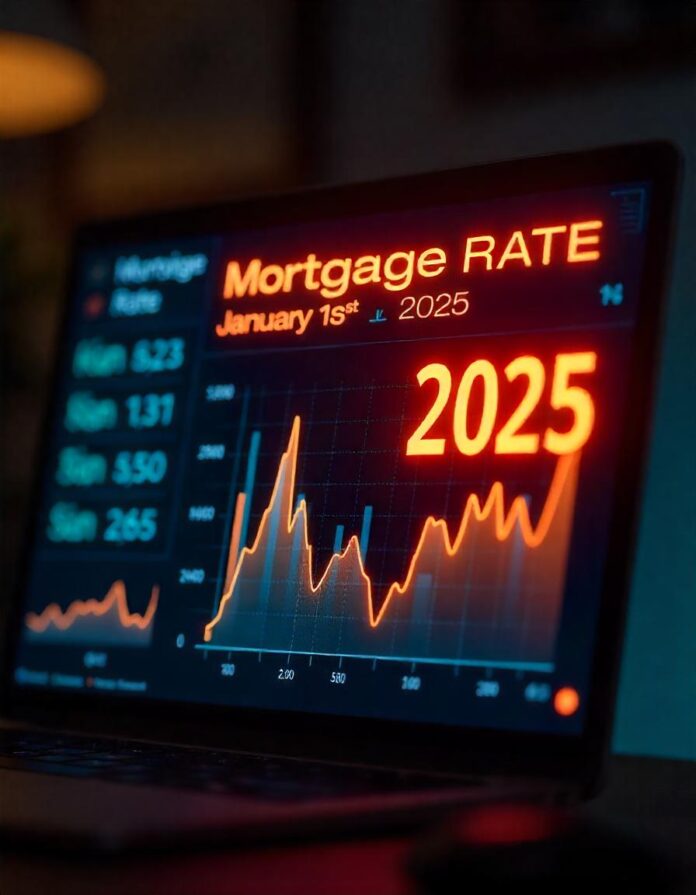On January 1st, 2025, we observe a significant climb in mortgage rate, impacting potential homeowners, investors, and the broader real estate market The financial landscape is continually shifting, and mortgage rates are no exception. . This article dives deeply into today’s mortgage rate trends, their causes, and what borrowers can do to navigate the changing market.
Current Mortgage Rates on January 1st, 2025
Today, the average 30-year fixed mortgage rate has climbed to 6.75%, up from 6.4% just a month ago. Similarly, the average 15-year fixed mortgage rate now stands at 5.9%, reflecting an upward trend driven by various economic factors. Adjustable-rate mortgages (ARMs) have also seen increases, with the 5/1 ARM rate hovering at 5.5%.You can as well read more about Average Mortgage rates
Key Factors Driving the Mortgage Rate Climb
1. Federal Reserve Policies
The Federal Reserve plays a pivotal role in influencing mortgage rates. Recent rate hikes aimed at curbing inflation have resulted in higher borrowing costs across the board. The current federal funds rate is at its highest level since 2007, which directly impacts long-term mortgage rates.
2. Inflation Trends
While inflation has moderated since its peak in 2023, it remains above the Federal Reserve’s target of 2%. Elevated inflation increases borrowing costs, pushing mortgage rates higher.
3. Economic Growth and Employment
The U.S. economy continues to exhibit resilience, with strong GDP growth and a low unemployment rate. While these are positive indicators, they also contribute to higher demand for credit, exerting upward pressure on rates.
4. Housing Market Dynamics
- Demand vs. Supply: Despite higher rates, demand for homes remains strong, especially in urban and suburban areas with limited housing inventory.
- Builder Confidence: Rising construction costs and labor shortages have slowed new home development, intensifying competition and maintaining high home prices.
How Rising Mortgage Rates Affect Borrowers
Higher mortgage rates can significantly alter a borrower’s financial outlook:
- Increased Monthly Payments: A higher interest rate directly translates to larger monthly payments, reducing affordability for many buyers.
- Reduced Loan Eligibility: Lenders tighten their criteria in high-rate environments, disqualifying some applicants.
- Impact on Refinancing: Current homeowners may hesitate to refinance their existing loans, especially if their current rates are significantly lower.
Strategies for Borrowers in a High-Rate Environment
1. Lock in Rates Early
When rates are climbing, locking in a mortgage rate can protect borrowers from further increases. Many lenders offer rate locks for up to 90 days.
2. Consider Adjustable-Rate Mortgages (ARMs)
While ARMs come with the risk of future rate adjustments, they often start with lower rates compared to fixed mortgages. This can be a cost-effective option for those planning to sell or refinance before the adjustment period.
3. Increase Down Payment
A larger down payment reduces the loan amount, leading to smaller monthly payments and potentially better interest rates.
4. Shop Around for the Best Rate
Different lenders may offer varying rates and terms. Comparing offers from multiple lenders can help borrowers secure more favorable conditions.
Impact of Higher Rates on the Housing Market
1. Slower Sales Activity
Higher mortgage rates deter some buyers, leading to reduced sales activity and longer listing times for homes.
2. Stabilization of Home Prices
While home prices remain elevated, higher rates may slow the pace of appreciation, creating opportunities for buyers who were previously priced out.
3. Shift to Rental Markets
As mortgages become less affordable, many potential buyers turn to rental properties, increasing demand in the rental market.

Expert Predictions for 2025 Mortgage Rates
Economists and financial analysts anticipate continued volatility in mortgage rates throughout 2025. However, there is hope that as inflation pressures ease and the Federal Reserve eventually pauses its rate hikes, mortgage rates may stabilize or even decrease in the latter half of the year.
FAQs About Today’s Mortgage Rates
1. Why are mortgage rates rising?
Mortgage rates are influenced by several factors, including Federal Reserve policies, inflation, and economic growth. Recent rate hikes and persistent inflation have been primary drivers of the increase.
2. How can I secure the best mortgage rate?
To secure the best rate, maintain a strong credit score, make a substantial down payment, and compare offers from multiple lenders.
3. Should I wait for rates to drop before buying a home?
Timing the market is challenging. If you find a home that fits your needs and budget, it may be wise to proceed while using strategies like rate locks to mitigate risk.
4. Will rates continue to climb in 2025?
While short-term increases are likely, long-term projections suggest rates may stabilize or decline as inflation moderates.
5. Are there alternatives to traditional mortgages in a high-rate environment?
Yes, alternatives like ARMs, interest-only loans, or shorter loan terms may offer lower initial rates, though they come with their risks.
Conclusion
The mortgage rate climb on January 1st, 2025, underscores the importance of staying informed and proactive in navigating the housing market. By understanding the factors driving these changes and employing strategic borrowing techniques, you can make sound financial decisions that align with your goals. For additional resources and expert advice, explore trusted financial blogs or consult with a mortgage professional


